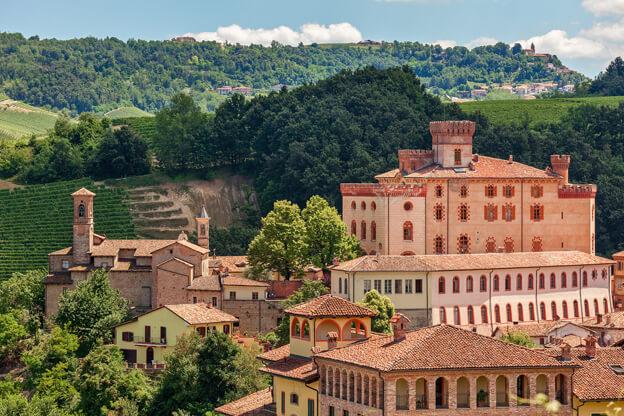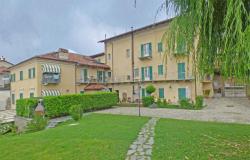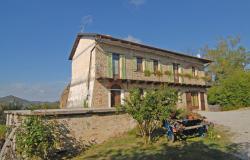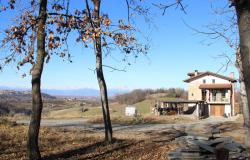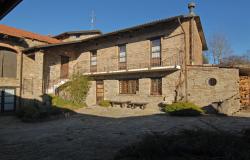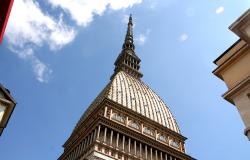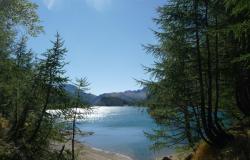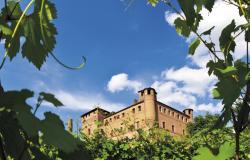[Photo: the town of Barolo in the Langhe, an area renowned for winemaking.]
The name of Italy’s second largest region – Piemonte – derives from medieval Latin Pedemontium or Pedemontis, meaning “at the foot of the mountains”. Piedmont is indeed surrounded on three sides by the Alps, which include the 3,841-meter-high Monviso, where the Po river begins, and Monte Rosa, the second highest mountain in the Alps.
It is not however all mountains in this region located in Italy’s north-western corner, at the border with France and Switzerland: from the highest peaks, the land slopes down to the gentle hills of the Langhe and Monferrato, Piedmont’s wine country, and to the Padan Plain, where rice fields abound; the provinces of Novara and Vercelli are in fact among Europe’s leading rice producers.
Right at the border with Lombardy, in the region’s north-eastern portion is beautiful Lake Maggiore, Italy’s second largest lake, framed by mountains. The pleasant lakeside town of Stresa is the gateway to the Borromean islands, which feature terraced gardens and aristocratic villas.

[Photo: Lake Maggiore and the Borromean islands.]
Piedmont’s main city is Turin, which, for the four years following the unification of Italy in 1861, was the country’s first capital, with the noble House of Savoy, who had reigned in the area for a long time, becoming the Kings of Italy until World War II. Cars, chocolate and a soccer team may be Turin’s “claim to fame”, but there’s more to this elegant city than Fiat, Gianduiotto and Juventus. Its long and important history is reflected in the city’s look, from the typical Roman street grid, still visible in the historic center, to the wide boulevards lined with porticoes and Baroque palaces, an Italo-French imprint given by the long domination of the House of Savoy.
A few kilometers outside Turin is the Palace of Venaria, the grand hunting residence of the Savoy family, built during the 17th and 18th centuries, and included in Unesco’s World Heritage list since 1997. The name of the palace derives from the Latin Venatio Regia, which means “Royal Hunt”.

[Venaria Palace, a former Savoy residence, just outside Turin.]
Only one hour south of Turin is Alba, the unofficial capital of Langhe, which was declared a Unesco World Heritage site in 2014, an area likely to be on every foodie’s favorite destinations list. It is famous for its wines, cheeses, and truffles—particularly the white truffles of Alba. Piedmont is one of the great wine-growing regions of Italy, with world-famous Barolo, Barbaresco and Barbera being produced right in the Langhe.
Twenty minutes to the west of Alba is Bra, the birthplace of the Slow Food movement, founded by Carlo Petrini in 1989 to prevent the disappearance of local food cultures and traditions. Every two years, Slow Food organizes the Cheese festival in Bra, with artisanal cheese makers from across the world.

[Scene from the Cheese festival in Bra, organized by Slow Food.]
Piedmont is clearly one of Italy’s leading gastronomic regions and it is perhaps no coincidence that Eataly, the upscale chain selling high-quality Italian foods and wines, was founded right in the region, when Italian businessman Oscar Farinetti converted a closed vermouth factory in Turin into the first location of Eataly. That was in 2007 and now Eataly boasts 27 stores around the world. The headquarters are still in Monticello d’Alba, in the province of Cuneo.
Piedmont is also home to the little-known Unesco-inscribed Sacri Monti (Italian for "Sacred Mountains"), a group of devotional complexes, built on the slopes of a mountain during the late 16th and 17th centuries, which feature a series of chapels containing scenes from the life of Christ, the Virgin Mary or the Saints, in the form of painting or sculptures. The skillful way they have been integrated in the surrounding natural landscapes is a reason why they have been added to the Unesco list.
 Piedmont is also ideal for a relaxing, pampering vacation thanks to the historic spa towns of Acqui Terme and Vinadio, where spring waters flow naturally. Incidentally, Acqui Terme is the main winemaking town for Brachetto, a red wine that is a favorite with desserts. In the center of town stands La Bollente (the hot one), a small pavilion designed in 1870 by Giovanni Ceruti housing a hot, natural spring fountain where the waters bubble at 75°C.
Piedmont is also ideal for a relaxing, pampering vacation thanks to the historic spa towns of Acqui Terme and Vinadio, where spring waters flow naturally. Incidentally, Acqui Terme is the main winemaking town for Brachetto, a red wine that is a favorite with desserts. In the center of town stands La Bollente (the hot one), a small pavilion designed in 1870 by Giovanni Ceruti housing a hot, natural spring fountain where the waters bubble at 75°C.
